兹维博迪金融学第二版课件Chapter01
- 格式:ppt
- 大小:345.00 KB
- 文档页数:45


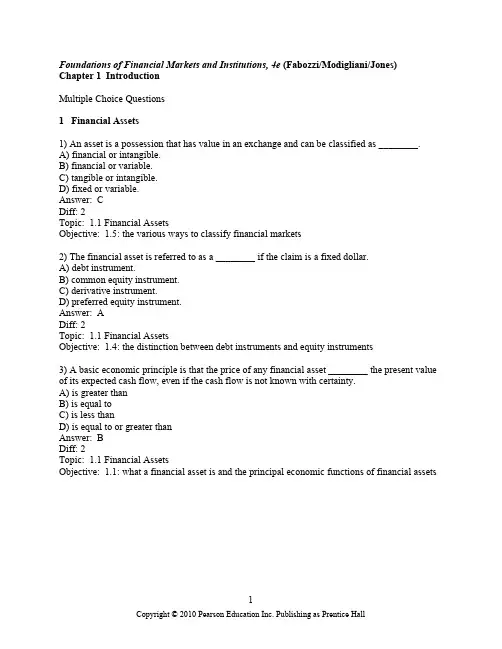
Foundations of Financial Markets and Institutions, 4e (Fabozzi/Modigliani/Jones) Chapter 1 IntroductionMultiple Choice Questions1 Financial Assets1) An asset is a possession that has value in an exchange and can be classified as ________.A) financial or intangible.B) financial or variable.C) tangible or intangible.D) fixed or variable.Answer: CDiff: 2Topic: 1.1 Financial AssetsObjective: 1.5: the various ways to classify financial markets2) The financial asset is referred to as a ________ if the claim is a fixed dollar.A) debt instrument.B) common equity instrument.C) derivative instrument.D) preferred equity instrument.Answer: ADiff: 2Topic: 1.1 Financial AssetsObjective: 1.4: the distinction between debt instruments and equity instruments3) A basic economic principle is that the price of any financial asset ________ the present value of its expected cash flow, even if the cash flow is not known with certainty.A) is greater thanB) is equal toC) is less thanD) is equal to or greater thanAnswer: BDiff: 2Topic: 1.1 Financial AssetsObjective: 1.1: what a financial asset is and the principal economic functions of financial assets4) A(n) ________ such as plant or equipment purchased by a business entity shares at least one characteristic with a financial asset: Both are expected to generate future cash flow for their owner.A) tangible assetB) intangible assetC) balance sheet assetD) cash assetAnswer: ADiff: 1Topic: 1.1 Financial AssetsObjective: 1.2: the distinction between financial assets and tangible assets5) Financial assets have two principal economic functions. Which of the below is ONE of these?A) A principal economic function is to transfer funds from those who have surplus funds to borrow to those who need funds to invest in intangible assets.B) A principal economic function is to transfer funds in such a way as to redistribute the avoidable risk associated with the cash flow generated by intangible assets among those seeking and those providing the funds.C) A principal economic function is to transfer funds in such a way as to redistribute the unavoidable risk associated with the cash flow generated by tangible assets among those seeking and those providing the funds.D) A principal economic function is to transfer funds from those who have surplus funds to invest to those who need funds to invest in intangible assets.Answer: CComment: Financial assets have two principal economic functions.(1) The first is to transfer funds from those who have surplus funds to invest to those who need funds to invest in tangible assets.(2) The second economic function is to transfer funds in such a way as to redistribute the unavoidable risk associated with the cash flow generated by tangible assets among those seeking and those providing the funds.Diff: 3Topic: 1.1 Financial AssetsObjective: 1.1: what a financial asset is and the principal economic functions of financial assets6) A principal economic function to transfer funds from those who have ________ to invest to those who need funds to invest in ________.A) deficit funds; tangible assets.B) surplus funds; intangible assets.C) deficit funds; intangible assets.D) surplus funds; tangible assets.Answer: DComment: Financial assets have two principal economic functions.(1) The first is to transfer funds from those who have surplus f unds to invest to those who need funds to invest in tangible assets.(2) The second economic function is to transfer funds in such a way as to redistribute the unavoidable risk associated with the cash flow generated by tangible assets among those seeking and those providing the funds.Diff: 2Topic: 1.1 Financial AssetsObjective: 1.1: what a financial asset is and the principal economic functions of financial assets 2 Financial Markets1) Financial markets provide three economic functions. Which of the below is NOT one of these?A) The interactions of buyers and sellers in a financial market determine the price of the traded asset.B) Financial markets provide a mechanism for an investor to sell a financial asset.C) Financial markets increases the cost of transacting.D) The interactions of buyers and sellers in a financial market determine the required return on a financial asset.Answer: CComment: Financial markets provide three economic functions.First, the interactions of buyers and sellers in a financial market determine the price of the traded asset. Or, equivalently, they determine the required return on a financial asset. As the nducement for firms to acquire funds depends on the required return that investors demand, it is this feature of financial markets that signals how the funds in the economy should be allocated among financial assets. This is called the price discovery process.Second, financial markets provide a mechanism for an investor to sell a financial asset. Because of this feature, it is said that a financial market offers liquidity, an attractive feature when circumstances either force or motivate an investor to sell. If there were not liquidity, the owner would be forced to hold a debt instrument until it matures and an equity instrument until the company is either voluntarily or involuntarily liquidated.While all financial markets provide some form of liquidity, the degree of liquidity is one of the factors that characterize different markets.The third economic function of a financial market is that it reduces the cost of transacting. There are two costs associated with transacting: search costs and information costs.Diff: 3Topic: 1.2 Financial MarketsObjective: 1.3: what a financial market is and the principal economic functions it performs2) The shifting of the financial markets from dominance by retail investors to institutional investors is referred to as the ________ of financial markets.A) globalizationB) institutionalizationC) securitizationD) diversificationAnswer: BDiff: 2Topic: 1.2 Financial MarketsObjective: 1.5: the various ways to classify financial markets3) Financial markets can be categorized as those dealing with newly issued financial claims that are called the ________, and those for exchanging financial claims previously issued that are called the ________.A) secondary market; primary market.B) financial market; secondary market.C) OTC market; NYSE/AMEX market.D) primary market; secondary market.Answer: DDiff: 2Topic: 1.2 Financial MarketsObjective: 1.6: the differences between the primary and secondary markets4) Business entities include nonfinancial and financial enterprises. ________ manufacture products such as cars and computers and/or provide nonfinancial services such as transportation and utilities.A) Financial enterprisesB) Nonfinancial enterprisesC) Both financial and nonfinancial enterprisesD) None of theseAnswer: BDiff: 1Topic: 1.2 Financial MarketsObjective: 1.7: the participants in financial markets3 Globalization of Financial Markets1) Which of the below is NOT a factor that has led to the integration of financial markets?A) A factor is liberalization of markets and the activities of market participants in key financial centers of the world.B) A factor is deregulation of markets and the activities of market participants in key financial centers of the world.C) A factor is technological advances for monitoring world markets, executing orders, and analyzing financial opportunities.D) A factor is decreased institutionalization of financial markets.Answer: DComment: The factors that have led to the integration of financial markets are (1) deregulation or liberalization of markets and the activities of market participants in key financial centers of the world; (2) technological advances for monitoring world markets, executing orders, and analyzing financial opportunities; and (3) increased institutionalization of financial markets. Diff: 3Topic: 1.3 Globalization of Financial MarketsObjective: 1.8: reasons for the globalization of financial markets2) A factor leading to the integration of financial markets is ________.A) decreased institutionalization of financial markets.B) increased monitoring of markets.C) technological advances for monitoring domestic markets, executing orders, and analyzing financial opportunities.D) technological advances for monitoring world markets, executing orders, and disregarding financial opportunities.Answer: DComment: The factors that have led to the integration of financial markets are (1) deregulation or liberalization of markets and the activities of market participants in key financial centers of the world; (2) technological advances for monitoring world markets, executing orders, and analyzing financial opportunities; and (3) increased institutionalization of financial markets. Diff: 2Topic: 1.3 Globalization of Financial MarketsObjective: 1.8: reasons for the globalization of financial markets3) From the perspective of a given country, financial markets can be classified as either internal or external. The internal market is composed of two parts: the domestic market and the foreign market. The domestic market is ________.A) where the securities of issuers not domiciled in the country are sold and traded.B) where issuers domiciled in a country issue securities and where those securities are subsequently traded.C) where securities are offered simultaneously to investors in a number of countries.D) where issuers domiciled in a country issue securities and where those securities are NOT subsequently traded.Answer: BDiff: 2Topic: 1.3 Globalization of Financial MarketsObjective: 1.10: the distinction between a domestic market, a foreign market, and the Euromarket4) A reason for a corporation using ________ is a desire by issuers to diversify their source of funding so as to reduce reliance on domestic investors.A) EuromarketsB) domestic equity marketsC) domestic government marketsD) None of theseAnswer: ADiff: 1Topic: 1.3 Globalization of Financial MarketsObjective: 1.11: the reasons why entities use foreign markets and Euromarkets4 Derivative Markets1) The two basic types of derivative instruments are ________ and ________.A) insurance contracts; options contractsB) futures/forward contracts; indenturesC) futures/forward contracts; legal contractsD) futures/forward contracts; options contractsAnswer: DDiff: 2Topic: 1.4 Derivative MarketsObjective: 1.12: what a derivative instrument is and the two basic types of derivative instruments2) Derivative instruments derive their value from ________.A) market conditions at time of delivery.B) market conditions at time of issue.C) the underlying instruments to which they relate.D) variations in the future claims conveyed from spot markets.Answer: CDiff: 2Topic: 1.4 Derivative MarketsObjective: 1.13: the role of derivative instruments3) Derivative contracts provide ________.A) issuers and investors an expensive but efficient way of controlling some major risks.B) issuers and investors an inexpensive way of controlling some major risks.C) issuers and investors an inexpensive but inefficient way of controlling all major risks.D) issuers and investors an expensive way of controlling some minor risks.Answer: BDiff: 1Topic: 1.4 Derivative MarketsObjective: 1.13: the role of derivative instruments4) Derivative markets may have at least three advantages over the corresponding cash (spot) market for the same financial asset. Which of the below is ONE of these advantages?A) Transactions typically can be accomplished faster in the derivatives market.B) It will always cost more to execute a transaction in the derivatives market in order to adjust the risk exposure of an investor's portfolio to new economic information than it would cost to make that adjustment in the cash market.C) All derivative markets can absorb a greater dollar transaction without an adverse effect on the price of the derivative instrument; that is, the derivative market may be more liquid than the cash market.D) Some derivative markets can absorb a greater dollar transaction but with an adverse effect on the price of the derivative instrument; that is, the derivative market may be more liquid than the cash market.Answer: AComment: Derivative markets may have at least three advantages over the corresponding cash (spot) market for the same financial asset.First, depending on the derivative instrument, it may cost less to execute a transaction in the derivatives market in order to adjust the risk exposure of an investor’’s portfolio to new economic information than it would cost to make that adjustment in the cash market. Second, transactions typically can be accomplished faster in the derivatives market.Third, some derivative markets can absorb a greater dollar transaction without an adverse effect on the price of the derivative instrument; that is, the derivative market may be more liquid than the cash market.Diff: 3Topic: 1.4 Derivative MarketsObjective: 1.13: the role of derivative instruments5 The Role of the Government in Financial Markets1) Which of the following statements is FALSE?A) Because of the prominent role played by financial markets in economies, governments have long deemed it necessary to regulate certain aspects of these markets.B) In their regulatory capacities, governments have had little influence on the development and evolution of financial markets and institutions.C) It is important to realize that governments, markets, and institutions tend to behave interactively and to affect one another's actions in certain ways.D) A sense of how the government can affect a market and its participants is important to an understanding of the numerous markets and securities.Answer: BComment: In their regulatory capacities, governments have greatly influenced the development and evolution of financial markets and institutions.Diff: 2Topic: 1.5 The Role of the Government in Financial MarketsObjective: 1.15 the different ways that governments regulate markets, including disclosure regulation, financial activity regulation, financial institution regulation, regulation of foreign firm participation, and regulation of the monetary system2) Which of the below statements is TRUE?A) Because of differences in culture and history, different countries regulate financial markets and financial institutions in varying ways, emphasizing some forms of regulation more than others.B) The standard explanation or justification for governmental regulation of a market is that the market, left to itself, will produce its particular goods or services in an efficient manner and at the lowest possible cost.C) Governments in most developed economies have created elaborate systems of regulation for financial markets, in part because the markets themselves are simple and in part because financial markets are unimportant to the general economies in which they operate.D) Financial activity regulation are free of rules about traders of securities and trading on financial markets.Answer: AComment: The standard explanation or justification for governmental regulation of a market is that the market, left to itself, will not produce its particular goods or services in an efficient manner and at the lowest possible cost.Governments in most developed economies have created elaborate systems of regulation for financial markets, in part because the markets themselves are complex and in part because financial markets are so important to the general economies in which they operate.Financial activity regulation consists of rules about traders of securities and trading on financial markets.Diff: 3Topic: 1.5 The Role of the Government in Financial MarketsObjective: 1.14: the typical justification for governmental regulation of markets3) The regulatory structure in the United States is largely the result of ________.A) the first IPO bubble in the 20th century.B) the boom in the stock market experienced in the 1990s.C) bull markets that have occurred at various times.D) financial crises that have occurred at various times.Answer: DDiff: 1Topic: 1.5 The Role of the Government in Financial MarketsObjective: 1.16 the U.S. Department of the Treasury's proposed plan for regulatory reform4) The proposal by the U.S. Department of the Treasury, popularly referred to as the "Blueprint for Regulatory Reform" or simply Blueprint, would replace the prevailing complex array of regulators with a regulatory system based on functions. More specifically, there would be three regulators. Which of the below is NOT one of these?A) market stability regulatorB) prudential regulatorC) uninhibited regulatorD) business conduct regulatorAnswer: CDiff: 2Topic: 1.5 The Role of the Government in Financial MarketsObjective: 1.15 the different ways that governments regulate markets, including disclosure regulation, financial activity regulation, financial institution regulation, regulation of foreign firm participation, and regulation of the monetary system6 Financial Innovation1) ________ increase the liquidity of markets and the availability of funds by attracting new investors and offering new opportunities for borrowers.A) Market-broadening instrumentsB) Market-management instrumentsC) Risk-management instrumentsD) Arbitraging-broadening instrumentsAnswer: AComment: The Economic Council of Canada classifies financial innovations into the following three broad categories:(1) market-broadening instruments, which increase the liquidity of markets and the availability of funds by attracting new investors and offering new opportunities for borrowers (2) risk-management instruments, which reallocate financial risks to those who are less averse to them, or who offsetting exposure and thus are presumably better able to should them(3) arbitraging instruments and processes, which enable investors and borrowers to take advantage of differences in costs and returns between markets, and which reflect differences in the perception of risks, as well as in information, taxation, and regulationsDiff: 2Topic: 1.6 Financial InnovationObjective: 1.17 the primary reasons for financial innovation2) The Economic Council of Canada classifies financial innovations into three broad categories. Which of the below is NOT one of these?A) market-broadening instrumentsB) risk-management instrumentsC) risk-broadening instrumentsD) arbitraging instruments and processesAnswer: CComment: The Economic Council of Canada classifies financial innovations into the following three broad categories:(1) market-broadening instruments, which increase the liquidity of markets and the availability of funds by attracting new investors and offering new opportunities for borrowers (2) risk-management instruments, which reallocate financial risks to those who are less averse to them, or who offsetting exposure and thus are presumably better able to should them(3) arbitraging instruments and processes, which enable investors and borrowers to take advantage of differences in costs and returns between markets, and which reflect differences in the perception of risks, as well as in information, taxation, and regulationsDiff: 2Topic: 1.6 Financial InnovationObjective: 1.17 the primary reasons for financial innovation3) There are two extreme views of financial innovation. Which of the below is ONE of these?A) Some hold that the essence of innovation is the introduction of financial assets that are less efficient for redistributing risks among market participants.B) There are some who believe that the minor impetus for innovation has been the endeavor to circumvent regulations and find loopholes in tax rules.C) Some hold that the essence of innovation is the introduction of financial instruments that are more efficient for redistributing risks among market participants.D) None of theseAnswer: CComment: There are two extreme views of financial innovation.There are some who believe that the major impetus for innovation has been the endeavor to circumvent (or arbitrage) regulations and find loopholes in tax rules.At the other extreme, some hold that the essence of innovation is the introduction of financial instruments that are more efficient for redistributing risks among market participants.Diff: 2Topic: 1.6 Financial InnovationObjective: 1.17 the primary reasons for financial innovation4) An ultimate and important cause of financial innovation does not involve ________.A) incentives to follow existing regulation and and tax laws.B) increased volatility of interest rates, inflation, equity prices, and exchange rates.C) changing global patterns of financial wealth.D) financial intermediary competition.Answer: AComment: It would appear that many of the innovations that have passed the test of time and have not disappeared have been innovations that provided more efficient mechanisms for redistributing risk. Other innovations may just represent a more efficient way of doing things. Indeed, if we consider the ultimate causes of financial innovation,the following emerge as the most important:1. Increased volatility of interest rates, inflation, equity prices, and exchange rates.2. Advances in computer and telecommunication technologies.3. Greater sophistication and educational training among professional market participants.4. Financial intermediary competition.5. Incentives to get around existing regulation and and tax laws.6. Changing global patterns of financial wealth.Diff: 2Topic: 1.6 Financial InnovationObjective: 1.17 the primary reasons for financial innovationTrue/False Questions1 Financial Assets1) An equity instrument (also called a residual claim) obligates the issuer of the financial asset to pay the holder an amount based on earnings, if any, after holders of debt instruments have been paid.Answer: TRUEDiff: 1Topic: 1.1 Financial AssetsObjective: 1.4: the distinction between debt instruments and equity instruments2) A intangible asset is one whose value depends on particular physical properties such as buildings, land, or machinery. Tangible assets, by contrast, represent legal claims to some future benefit.Answer: FALSEComment: A tangible asset is one whose value depends on particular physical properties such as buildings, land, or machinery. Intangible assets, by contrast, represent legal claims to some future benefit.Diff: 1Topic: 1.1 Financial AssetsObjective: 1.2: the distinction between financial assets and tangible assets3) Financial assets have two principal economic functions. One function is to transfer funds from those who have surplus funds to invest to those who need funds to invest in tangible assets. Answer: TRUEDiff: 1Topic: 1.1 Financial AssetsObjective: 1.1: what a financial asset is and the principal economic functions of financial assets 2 Financial Markets1) The three economic functions of financial markets are: to improve the price discovery process; to lessen liquidity; and, to reduce the cost of transacting.Answer: FALSEComment: The three economic functions of financial markets are: to improve the price discovery process; to enhance liquidity; and to reduce the cost of transacting.Diff: 2Topic: 1.2 Financial MarketsObjective: 1.3: what a financial market is and the principal economic functions it performs2) The market participants include households, business entities, national governments, national government agencies, state and local governments, supranationals, and regulators.Answer: TRUEDiff: 1Topic: 1.2 Financial MarketsObjective: 1.3: what a financial market is and the principal economic functions it performs3) One economic function of a financial market is to reduce the cost of transacting. There are two costs associated with transacting: search costs and information costs.Answer: TRUEDiff: 1Topic: 1.2 Financial MarketsObjective: 1.3: what a financial market is and the principal economic functions it performs3 Globalization of Financial Markets1) Globalization means the integration of financial markets throughout the world into an international financial market.Answer: TRUEDiff: 1Topic: 1.3 Globalization of Financial MarketsObjective: 1.8: reasons for the globalization of financial markets2) The domestic market in any country is the market where the securities of issuers not domiciled in thecountry are sold and traded.Answer: FALSEComment: The foreign market in any country is the market where the securities of issuers not domiciled in the country are sold and traded.Diff: 1Topic: 1.3 Globalization of Financial MarketsObjective: 1.10: the distinction between a domestic market, a foreign market, and the Euromarket3) Global competition has forced governments to exercise control various aspects of their financial markets so that their financial enterprises can compete effectively around the world. Answer: FALSEComment: Global competition has forced governments to deregulate (or liberalize) various aspects of their financial markets so that their financial enterprises can compete effectively around the world.Diff: 1Topic: 1.3 Globalization of Financial MarketsObjective: 1.8: reasons for the globalization of financial markets4 Derivative Markets1) Derivative instruments play a critical role in global financial markets.Answer: TRUEDiff: 1Topic: 1.4 Derivative MarketsObjective: 1.13: the role of derivative instruments2) IBM pension fund owns a portfolio consisting of the common stock of a large number of companies. Suppose the pension fund knows that two months from now it must sell stock in its portfolio to pay beneficiaries $20 million. The risk that IBM pension fund faces is that two months from now when the stocks are sold, the price of most or all stocks may be higher than they are today.Answer: FALSEComment: IBM pension fund owns a portfolio consisting of the common stock of a large number of companies. Suppose the pension fund knows that two months from now it must sell stock in its portfolio to pay beneficiaries $20 million. The risk that IBM pension fund faces is that two months from now when the stocks are sold, the price of most or all stocks may be lower than they are today.Diff: 2Topic: 1.4 Derivative MarketsObjective: 1.13: the role of derivative instruments3) When the option grants the owner of the option the right to buy a financial asset from the other party, the option is called a put option.Answer: FALSEComment: When the option grants the owner of the option the right to buy a financial asset from the other party, the option is called a call option.Diff: 2Topic: 1.4 Derivative MarketsObjective: 1.13: the role of derivative instruments5 The Role of the Government in Financial Markets1) The market stability regulator would take on the traditional role of the Federal Reserve by giving it the responsibility and authority to ensure overall financial market stability.Answer: TRUEDiff: 1Topic: 1.5 The Role of the Government in Financial MarketsObjective: 1.15 the different ways that governments regulate markets, including disclosure regulation, financial activity regulation, financial institution regulation, regulation of foreign firm participation, and regulation of the monetary system2) Blueprint regulation is the form of regulation that requires issuers of securities to make publica large amount of financial information to actual and potential investors.Answer: FALSEComment: Disclosure regulation is the form of regulation that requires issuers of securities to make public a large amount of financial information to actual and potential investors.Diff: 1Topic: 1.5 The Role of the Government in Financial MarketsObjective: 1.16 the U.S. Department of the Treasury's proposed plan for regulatory reform3) Financial activity regulation is the form of regulation that requires issuers of securities to make public a large amount of financial information to actual and potential investors. Answer: FALSEComment: Disclosure regulation is the form of regulation that requires issuers of securities to make public a large amount of financial information to actual and potential investors.NOTE. Financial activity regulation consists of rules about traders of securities and trading on financial markets.Diff: 1Topic: 1.5 The Role of the Government in Financial MarketsObjective: 1.14: the typical justification for governmental regulation of markets。

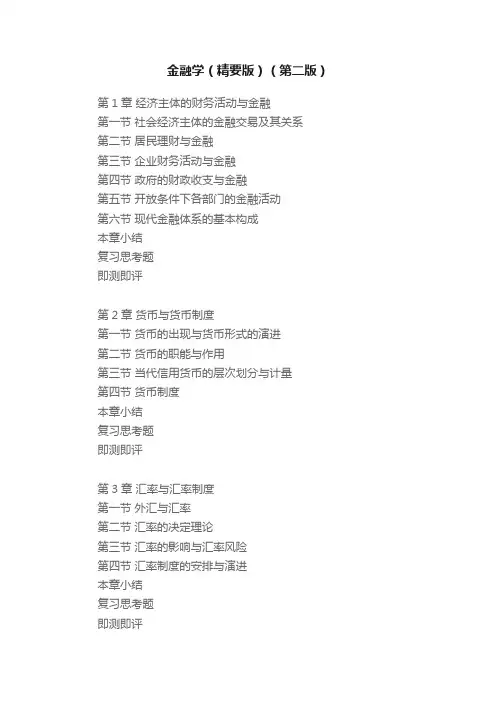
金融学(精要版)(第二版)第1章经济主体的财务活动与金融第一节社会经济主体的金融交易及其关系第二节居民理财与金融第三节企业财务活动与金融第四节政府的财政收支与金融第五节开放条件下各部门的金融活动第六节现代金融体系的基本构成本章小结复习思考题即测即评第2章货币与货币制度第一节货币的出现与货币形式的演进第二节货币的职能与作用第三节当代信用货币的层次划分与计量第四节货币制度本章小结复习思考题即测即评第3章汇率与汇率制度第一节外汇与汇率第二节汇率的决定理论第三节汇率的影响与汇率风险第四节汇率制度的安排与演进本章小结复习思考题即测即评第4章信用与信用体系第一节信用概述第二节信用形式第三节信用体系本章小结复习思考题即测即评第5章货币的时间价值与利率第一节货币的时间价值与利息第二节利率分类及其与收益率的关系第三节利率的决定及其影响因素第四节利率的作用及其发挥本章小结复习思考题即测即评第6章金融资产与价格第一节金融工具与金融资产第二节金融资产的价格第三节金融资产定价第四节金融资产价格与利率、汇率的关系本章小结复习思考题即测即评……第7章投融资活动与金融市场第8章货币市场第9章资本市场第10章衍生工具市场第11章金融机构体系第12章存款性公司第13章其他金融性公司第14章中央银行第15章货币需求第16章货币供给第17章货币均衡第18章货币政策第19章金融监管第20章金融发展参考文献。
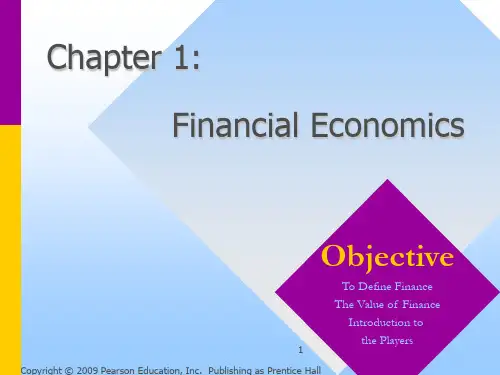
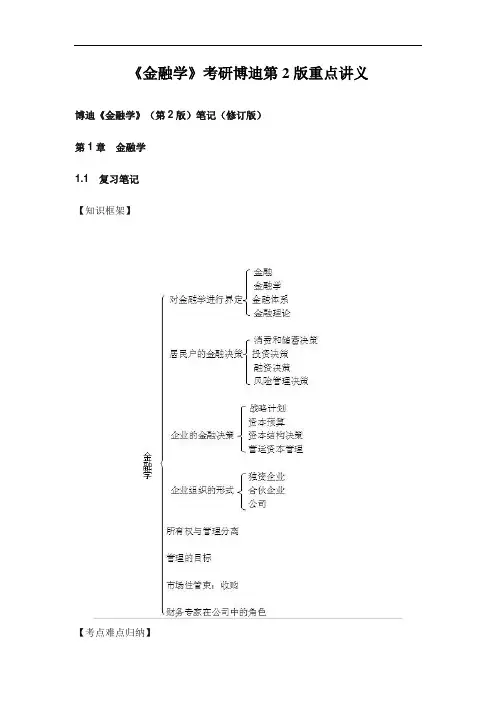
《金融学》考研博迪第2版重点讲义博迪《金融学》(第2版)笔记(修订版)第1章金融学1.1复习笔记【知识框架】【考点难点归纳】考点一:对金融学进行界定1金融金融是货币流通、信用活动及与之相关的经济行为的总称。
简言之,就是货币资金的融通。
一般是指以银行、证券市场等为中心的货币流通和信用调节活动,包括货币的发行和流通、存款的吸收和提取、贷款的发放和收回、国内外汇兑往来、有价证券的发行和流通、保险、信托、抵押、典当以及各种金融衍生工具交易等。
按金融中介机构是否充当资金转移的媒介,金融可以分为直接金融(direct finance)和间接金融(indirect finance)。
2金融学金融学是一项针对人们怎样跨期配置稀缺资源的研究。
金融决策区别于其他资源配置决策的两项特征是:①金融决策的成本和收益是跨期分摊的;②无论是决策者还是其他人,通常都无法预先确知金融决策的成本和收益。
金融学是主要研究货币领域的理论及货币资源的配置与选择、货币与经济的关系及货币对经济的影响、现代银行体系的理论和经营活动的经济学科,是当代经济学的一个相对独立而又极为重要的分支。
金融学所涵盖的内容极为丰富,诸如货币原理、货币信用与利息原理、金融市场与银行体系、储蓄与投资、保险、信托、证券交易、货币理论、货币政策、汇率及国际金融等。
3金融体系金融体系是金融市场与金融机构的集合,这些集合被用于金融合同的订立以及资产和风险的交换。
金融体系是由连接资金盈余者和资金短缺者的一系列金融中介机构和金融市场共同构成的一个有机体,包括股票、债券和其他金融工具的市场、金融中介(如银行和保险公司)、金融服务公司(如金融咨询公司)以及监控管理所有这些单位的管理机构等。
研究金融体系如何发展演变是金融学科的重要方面。
4金融理论金融理论由一系列概念和数量化模型组成。
概念帮助人们思考如何在时间上配置资源;数量化模型用于估价替代方案、制定决策和执行决策。
各个层次的决策都采用同样的基本概念和数量化模型。

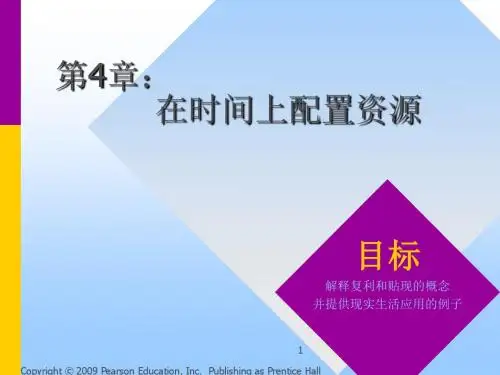


金融学兹维博迪第二版第一章答案本页仅作为文档封面,使用时可以删除This document is for reference only-rar21year.MarchCHAPTER 1 – Financial Economics End-of-Chapter Problems Defining Finance 1. What are your main goals in life How does finance play a part in achieving those goals What are the major tradeoffs you face SAMPLE ANSWER: • • • Finish school Get good paying job which I like Get married and have children Own my own home Provide for family Pay for children’s education Retire How Finance Plays a Role: SAMPLE ANSWER: • Finance helps me pay for undergraduate and graduate education and helps me decide whether spending the money on graduate education will be a good investment decision or not. • • Higher education should enhance my earning power and ability to obtain a job I like. Once I am married and have children I will have additional financial responsibilities (dependents) and I will have to learn how to allocate resources among individuals in the household and learn how to set aside enough money to pay for emergencies, education, vacations etc. Finance also helps me understand how to manage risks such as for disability, life and health. • Finance helps me determine whether the home I want to buy is a good value or not. The study of finance also helps me determine the cheapest source of financing for the purchase of that home. Finance helps me determine how much money I will have to save in order to pay for my children’s • education as well as my own retirement. Major Tradeoffs: SAMPLE ANSWER • Spend money now by going to college (and possibly graduate school) but presumably make more money once I graduate due to my higher education. Consume now and have less money saved for future expenditures such as for a house and/or car or save • more money now but consume less than some of my friends Financial Decisions of Households 2. What is your net worth What have you included among your assets and your liabilities Would you list the value of your potential lifetime earning power as an asset or liability How does it compare in value to other assets you have listed Chapter 1 - 1SAMPLE ANSWER: $ ____________ (very possibly negative at this point) Assets: • • • • Checking account balance Savings account balance Furniture/Jewelry (watch) Car (possibly) Liabilities: • • • • Student loans Credit card balance If renting, remainder of rental agreement (unless subletting is a possibility) Car payments (possibly) Students typically don’t think about the high value of their potential lifetime earning power when calculating their net worth but for young people it is often their most valuable asset. 3. How are the financial decisions faced by a single person living alone different from those faced by the head of a household with responsibility for several children of school age Are the tradeoffs they have to make different, or will they evaluate the tradeoffs differently A single person needs only to support himself and therefore can make every financial decision on his own. If he does not want health insurance (and is willing to bear the financial risks associated with that decision) then no one will be affected by that decision other than that single person. In addition, this person needs to make no decisions about allocating income among dependents. A single person is very mobile and can choose to live almost anywhere.The tradeoffs this individual makes generally concern issues of consuming (or spending) today versus saving for consumption tomorrow. Since this person is supporting only himself, the need to save now is less important than for the head of household discussed next. The head of household with several children must share resources (income) among dependents. This individual must be prepared to deal with risk management issues such as how to be prepared for potential financial emergencies (such as a serious health problem experienced by a member of the family or home owners insurance in case of a fire or other mishap). Because there are more people in this household than with a single person, there are greater risks that someone will get sick or injured. And because there are dependents, the wage earner(s) should think carefully about life and disability insurance. In addition, the family is not as mobile as the single individual. Because of the school age children, the family might want to live near “good schools” thinking that a stronger education wi ll eventually help those children’s future well being and financial situation. Thus, the tradeoffs for the head o f household are more complex: more money is needed to consume today (he or she needs to support more dependents), but a lot more money is also needed to save for future expenses such as education and housing and more money is needed for risk management such as life and disability insurance. 4. Family A and family B both consist of a father, mother and two children of school age. In family A both spouses have jobs outside the home and earn a combined income of $100,000 per year. In family B, only one spouse works outside the home and earns $100,000 per year. How do the financial circumstances and decisions faced by the two families differ With two wage earners, there is less risk of a total loss of family income due to unemployment or disability than there is in a single wage earning household. The single wage earning family will probably want more disability and life insurance than the two wage earning family. On the flip side, however, the two wage earning family may need to spend extra money on child care expenses if they need to pay someone to watch the children after school. Chapter 1 - 25. Suppose we define financial independence as the ability to engage in the four basic household financial decisions with out resort to the use of relative’s resources when making financing decisions. At what age should children be expected to become financially independent Students will have differing responses to this question depending upon their specific experiences and opinions. Most will probably say independence should come after finishing their education, and they have a significant flow of income. 6. You are thinking of buying a car. Analyze the decision by addressing the following issues: a. Are there are other ways to satisfy your transportation requirements besides buying a car Make a list of all the alternatives and write down the pros and cons. Transportation Mode Walking Pros Cons Takes a long time Destination may be too far • Takes you directly where you want to go • • • • • No out of pocket costs Convenient Bicycle Bus • • Takes you directly to where you want to go Requires physical strength and endurance • • • • No out of pocket marginal costs Convenient Destination may be too far Inexpensive • May not take you directly where you want to go Reaches more distant destinations • • • Inconvenient schedules to go Many stops, not efficient Subway • • Inexpensive Fast May not take you directly where you want to go • Local destinations only on limited network Train • • • Reaches distant destinations Moderately expensive May not take you directly where you want to go Airplane • • • • Reaches distant destinations Fast Most expensive Will not take you directly where you want to go b. What are the different ways you can finance the purchase of a car Finance through a bank loan or lease, finance through a car dealer with a loan or a lease or finance the car out of your own savings. c. Obtain information from at least three different providers of automobile financing on the terms they offer. d. What criteria should you use in making your decision Your decision will be to select the financing alternative that has the lowest cost to you. When analyzing the information, you should consider the following: • Do you have the cash saved to make an outright purchase What interest rate would you be giving up to make that purchase Do you pay a different price for the car if you pay cash rather than financeChapter 1 - 3• For differing loan plans, what is the down payment today What are the monthly payments For how long What is the relevant interest rate you will be paying Does the whole loan get paid through monthly payments or is there a balloon payment at the end Are taxes and/or insurance payments included in the monthly payments • For differing lease plans, what is the down payment today What are the monthly payments For how long Do you own the car at the end of the lease If not, what does it cost to buy the car Do you have to buy the car at the end of the lease or is it an option Is there a charge if you decide not to buy the car What relevant interest rate will you be paying Are taxes and/or insurance payments included in the monthly payments Are there mileage restrictions 7. Match each of the following examples with one of the four categories of basic types of household financial decisions. At the Safeway paying with your debit card rather than taking the time to write a check Deciding to take the proceeds from your winning lottery ticket and use it to pay for an extended vacation on the Italian Riviera Following Hillary’s advice and selling y our Microsoft shares to invest in pork belly futures Helping your 15-year old son learn to drive by letting putting him behind the wheel on the back road into town Taking up the offer from the pool supply company to pay off your new hot tub with a 15-month loan with zero payments for the first three months The first is the most difficult since in practice it is simply a cash transaction involving no financing. As such the purchase is a consumption decision only and the payment choice is not a financing decision. The second is also a consumption/saving decision. The third is an exchange of one financial asset for another and therefore an investment decision. The fourth is a risk-management decision since you have subjected yourself to increased risk that is not covered by insurance. The final example is a financing decision involving a loan to finance a purchase. Forms of Business Organization 8. You are thinking of starting your own business, but have no money. a. Think of a business that you could start without having to borrow any money. Any business that involves a student’s own personal service would be cheap to start up. For instance he or she could start a business running errands for others, walking their dogs, shopping etc. Along those same lines they could start some kind of consulting business. Both of these businesses could be run out of their dorm room or their own home and could be started with very little capital. If they wanted to hire additional workers, they would have to be paid on a commission basis to limit upfront expenses. b. Now think of a business that you would want to start if you could borrow any amount of money at the going market interest rate. Certainly there are many interesting businesses that could be started if one could finance 100% of the business with borrowed capital and no equity. Since you will be able to borrow 100% of the financing, you will be willing to take a lot greater risk than if you were investing your own money. c. What are the risks you would face in this business [Answer is, of course, dependent on answer to question “b.”] d. Where can you get financing for your new business Depending upon the size of the financing needed, students should be looking for both debt and equity financing. The sources of this financing ranges from individuals and credit cards (for very small sums) to banks, venture capitalists, public debt and equity markets, insurance companies and pension funds Chapter 1 - 49. Choose an organization that is not a firm, such as a club or church group and list the most important financial decisions it has to make. What are the key tradeoffs the organization faces What role do preferences play in choosing among alternatives Interview the financial manager of the organization and check to see if he or she agrees with you. SAMPLE ANSWER: Local Church group. Most important financial decisions: • Whether or not to repair damage done to church and grounds during last big hurricane (specifically repairing the leaking roof) • • • • What project to put off in order to pay for repair damage How to pay for renovations to downstairs Sunday school rooms How to increase member attendance and contributions How to organize and solicit volunteers for the annual Church Sale (largest fund raiser of the year) Key Tradeoffs and Preferences: Church group funds are severely limited, so the organization needs to prioritize expenses based upon cost and need. Not all projects that are needed will be undertaken due to the expense involved. An equally large amount of time will be spent trying to raise financing since funds inflow is variable. Since not all projects can be financed, preferences of different important individuals (such as the pastor) take on great significance in the decision-making process. Market Discipline: Takeovers 10. Challenge Question: While there are clear advantages to the separation of management from ownership of business enterprises, there is also a fundamental disadvantage in that it may be costly to align the goals of management with those of the owners. Suggest at least two methods, other than the takeover market, by which the conflict can be reduced, albeit at some cost. One way is to provide incentives for the managers so that they increase their pay when owners interests are improved. An example would be compensating managers with stock options, the value of which increase with the market value of shareholder’s interests. A second method is to more closely monitor the behavior of the managers. Outside management consultants and auditors serve this role in part particularly to the extent that they report their findings to representatives from ownership groups. Both of these solutions assume the management cannot effectively deceive markets or consultant/auditors through misleading information or actions to inflate the market value of the ownership shares or there performance records. 11. Challenge Question: Consider a poorly run local coffee shop with its prime location featuring a steady stream of potential clients passing by on their way to and from campus. How does the longtime disgruntled, sloppy and inefficient owner-manager of Cup-a-Joe survive and avoid disciplining from the takeover market This is not a question about a misalignment of the goals of the owner(s) and manager(s) of a firm since we have explicitly said the firm is owner-managed. If in fact the coffee shop is mismanaged the potential exists for an outsider to purchase a controlling interest in the operation and put more efficient management into place if the purchase price does not exceed the value of profits to be generated by the efficiently managed firm. If the present owner chooses not to sell he must value the firm for more than the value of the profits generated by an efficiently managed firm. Therefore his position in the firm must generate for him non-pecuniary benefits, or benefits unrelated to the firm’s profitability and he is therefore not a value maximizer. Perhaps he enjoys making fun of his clients or takes pride in his eclectic tastes in interior decorating. In any case the takeover market does discipline him in the sense that he will be forced to pay for his non-pecuniary benefits in the sense that he trades off profits. Chapter 1 - 5Copyright ©The same could be said of an owner-manager who lacks the required specialized skills to properly run the firm but never the less continues to operate the compa ny inefficiently because he ‘likes’ the work! The Role of the Finance Specialist in a Corporation 12. Which of the following tasks undertaken within a corporate office are likely to fall under the supervision of the treasurer The controller Arranging to extend a line of credit from a bank Arranging with an investment bank for a foreign exchange transaction Producing a detailed analysis of the cost structure of the company’s alternative product lines Taking cash payments for company sales and purchasing . Treasury Bills Filing quarterly statements with the Securities and Exchange Commission The first two and the fourth items are responsibilities of the treasurer while the third and fifth items fall under the workload of the controller’s office. Chapter 1 - 62009 Pearson Education, Inc. Publishing as Prentice Hall. Objectives Define finance. Explain why finance is worth studying. Introduce two of the main players in the world of finance —households and firms —and the kinds of financial decisions they make. The other main players, financial intermediaries and government, are introduced in chapter 2. Contents Defining Finance Why Study Finance Financial Decisions of Households Financial Decisions of Firms Forms of Business Organization Separation of Ownership and Management The Goal of Management Market Discipline: Takeovers The Role of the Finance Specialist in a Corporation Summary Finance is the study of how to allocate scarce resources over time. The two features that distinguish finance are that the costs and benefits of financial decisions are spread out over time and are usually not known with certainty in advance by either the decision maker or anybody else. A basic tenet of finance is that the ultimate function of the system is to satisfy people’s consumption preferences. Economic organizations such as firms and governments exist in order to facilitate the achievement of that ultimate function. Many financial decisions can be made strictly on the basis of improving the trade-offs available to people without knowledge of their consumption preferences. There are at least five good reasons to study finance: y y y y y To manage your personal resources. To deal with the world of business. To pursue interesting and rewarding career opportunities. To make informed public choices as a citizen. To expand your mind. The players in finance theory are households, business firms, financial intermediaries, and governments. Households occupy a special place in the theory because the ultimate function of the system is to satisfy the preferences of people, and the theory treats those preferences as given. Finance theory explains household behavior as an attempt to satisfy those preferences. The behavior of firms is viewed from the perspective of how it affects the welfare of households. Households face four basic types of financial decisions: y y y Saving decisions: How much of their current income should they save for the future Investment decisions: How should they invest the money they have saved Financing decisions: When and how should they use other people’s money to satisfy their wants and needs y Risk-management decisions: How and on what terms should they seek to reduce the economic uncertaintiesthey face or to take calculated risks There are three main areas of financial decision making in a business: capital budgeting, capital structure, and working capital management. Chapter 1 - 7Financial Economics Solutions ManualThere are five reasons for separating the management from the ownership of a business enterprise: y y y Professional managers may be found who have a superior ability to run the business. To achieve the efficient scale of a business the resources of many households may have to be pooled. In an uncertain economic environment, owners will want to diversify their risks across many firms. Such efficient diversification is difficult to achieve without separation of ownership and management. y y To achieve savings in the costs of gathering information. The “learning curve” or “going concern” effect: When th e owner is also the manager, the new owner has to learn the business from the former owner in order to manage it efficiently. If the owner is not the manager, then when the business is sold, the manager continues in place and works for the new owner. The corporate form is especially well suited to the separation of ownership and management of firms because it allows relatively frequent changes in owners by share transfer without affecting the operations of the firm. The primary goal of corporate management is to maximize shareholder wealth. It leads managers to make the same investment decisions that each of the individual owners would have made had they made the decisions themselves. A competitive stock market imposes a strong discipline on managers to take actions to maximize the market value of the firm’s shares. Chapter 1 - 8 2009 Pearson Education, Inc. Publishing as Prentice Hall.。
博迪莫顿版金融学(第二版)课后习题答案————————————————————————————————作者:————————————————————————————————日期:金融学(第二版)答案博迪默顿第一章课后习题答案一 . 我的生活目标:●完成学业●找到一份自己喜欢且收入不菲的工作●结婚和生养子女●拥有我自己的房子●供养我的家庭生活●供养孩子上学●退休在我实现目标的过程中,金融所扮演的角色:答案样例:1,金融现在可以为我提供大学本科及研究生教育的学费并帮我完成学业,帮我决定投资于上学是否是一个好的投资决定 2,高等教育可以帮助提高我赚钱的能力以及获得一个我喜欢的工作的能力 3,当我结婚并且有了孩子以后,我就有了额外的金融责任(以具体情况而定),我必须学会如何在家庭中的个人之间分配资源,学会如何留置一定的资金以用之于紧急事件,教育,假期旅游等;金融也帮助我理解如何应对危机,比如残疾,生活,健康 4,金融也帮我决定我想买的房子是否值钱,也帮我如何用最少的金融资源购买那所房子 5,金融帮我决定我应该储蓄多少钱以备我子女的学业和我以后的退休我主要的权衡决策:答案样例:1,现在花钱接受高等教育(并完成学业)可是假设以后由于我的高等教育文凭挣更多的钱 2,现在消费更多为以后比如买房,买车或储蓄留置很少的钱还是现在消费很少,甚至少于我的许多朋友二.答案样例:净值=资产-负债$__________(很可能会被低估)资产包括:经常帐户余额储蓄存款帐户余额家具设备,首饰类(如表)车(如果有的话)负债包括:学生贷款信用卡结余的差额各种租用金的协定(不包括转租)应付车款在计算净值时学生会特别地排除了他们一生潜在的赚钱能力的价值三.一个单身汉之需要养活他自己,所以他可以独立自主的作出金融决策。
如果他不想购买健康保险(而愿意承担由这个决定而带来的金融风险)那么除了这个单身汉自身,没谁会受这个决定的影响。
另外,他不需要在家庭成员之间分配收入这件事上做任何决定。